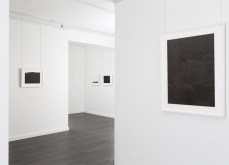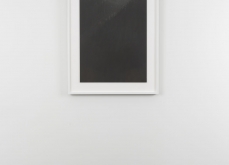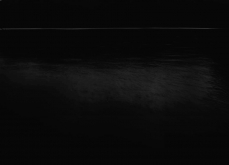 Arcadia
Arcadia
February 26, 2014 – April 11, 2014
Opening Reception: Wednesday, February 26 from 6-8 PM
Christian Duvernois Gallery will open with its inaugural show, a solo exhibition by contemporary Slovakian artist Lucia Papčo, entitled Arcadia. The 12 photographs and 6-minute video featured in the show, taken in the forested mountains of Papčo’s native Slovakia, capture the sublime, yet fleeting moments when light, angle and shadow align to reveal a more perfect vision of the landscape.
In many cases, the light conditions she sought to capture occur only a few days of the year, for a few minutes per day. The ephemeral nature of these “Arcadian moments” required the artist to spend a significant amount of time observing and documenting the changes in light and how they affected her perception of place.
Papčo describes her process of searching for such optimal conditions with a large format camera as, “a limit set by reality, with its geographic-lighting potentialities and my own opportunities to translocate myself in space with the equipment I need. [It] creates an important part of the work. It’s a kind of struggle with reality.”
Papčo limits herself to traditional black and white photography and, in order to imbue the images with a certain level of realism, avoids digital manipulation. By underexposing the photographs and transforming a colored reality into a monochromatic image, Papčo evokes a sense of abstraction from the physical environment. It may seem to the viewer as if the images were conceived from something that is disappearing, or has yet to be discovered.
Exhibition Installation Images
Lucia Papčo
SHORT BIOGRAPHY
Papčo, born in 1987 in Bratislava, is represented in the Essl Museum Collection in Austria and in prominent private collections in Slovakia, Portugal, Germany and the USA. Her work explores the intersection between photography and other graphic techniques as well as the distortion of plot and space.
Papčo received a Magister of Art from the Academy of Fine Arts, Vienna, Austria in 2012, and previously studied at the Academy of Fine Arts and Design in Bratislava, Slovakia, and at the Academy of Fine Arts in Prague, Czech Republic.
AWARDS
Essl Art Award CEE, 2009.
Residency Unlimited, New York City, 2013
SELECTED SOLO EXHIBITIONS
2013
He Who Passes Through That Country, OPEN Gallery, Bratislava, Slovakia
John In Love Show, Photoport Gallery, Bratislava, Slovakia
2012
That Country, Projectroom, Cyprian Majernik Gallery, Bratislava, Slovakia
John in Love, Photoport Gallery, Bratislava, Slovakia
2011
Bright Side of The Horse, 35m2 Gallery, Prague, Czech Republic
SELECTED GROUP EXHIBITIONS
2013
The World And It’s Things In The Middle Of Their Intimacy, Fridman Gallery, NewYork City, USA
Like it!, Essl Museum – Contemporary Art, Klosterneuburg, Austria.
Hans Knoll – selected works from “Knoll talks” in Reality Group Exhibition- Raum Residenz, Atelier Suterena,Vienna, Austria
Liminal Inversions, Residency Unlimited, New York, USA
Layers, Medium Gallery, Bratislava, Slovakia
2012
Weird Scenes Inside The Gold Mine, Parker’s Box Gallery, Brooklyn, NewYork
2011
A Youthful Medium, House of Art, Bratislava, Slovakia
The Picture we Live In, Museum of the City of Usti nad Labem, Czech Republic
All my Lovin, Sirius Arts Center, Cork, Ireland
2010
Statement, Paris Photo, Carrousel du Louvre, Paris, France
Yeasty Medium, Slovak Photography 1990-2010, House of Art, Bratislava, Slovakia
Second Halftime, Maribor Art Gallery, Maribor, Slovenia
All My Lovin, Lodź Art Center, Lodź, Poland
Familial Feeling, House of Photography, Liptovsky Mikulas, Slovakia
Photoport vol. 1, University of Jyväskylä, Finland Photoport vol. 1, Cultural Center in Espoo, Finland
“Welcome to the Forest”
By Deidre Dononhue
Stephanie Shuman Librarian
International Center of Photography
When my grandfather was born in Slovakia, before the start of the “The Great War,” his home was inside of the Austro-Hungarian Empire, but he thought of his village as a small clearing in a vast, dark, impenetrable forest. The only ruler he recognized was nature.
Gradually, as other rulers acted upon that landscape, and on the inhabitants of that clearing, his perceptions changed, and the forest became very penetrable, after all.
In the century since then, it has been more and more evident that nature is not the most powerful ruler of them all, and that, standing in the middle of Europe, perceptions must necessarily shift while nature is locked in a perpetual tango with civilization.
Arcadia suggests you consider uncorrupted timeless beauty of the landscapes. It encourages poetic notions about the benevolent rule of nature and an aesthetic pleasure that can be found therein. Looking at the images by Lucia Papčo gathered in this exhibition, the eye re-adjusts and perceptions change. The invisible gradually reveals itself. The viewer is more than witness. The viewer is willingly participating in traversing the border between the visible and the invisible. Nature may actually be the ruler in these pictures. Or, perhaps, another unseen ruler will be gradually perceived in their depths after due deliberation.
Czech art historian Antonin Matějček, wrote in 1910 “An Expressionist wishes, above all, to express himself… (an Expressionist rejects) immediate perception and builds on more complex psychic structures… Impressions and mental images that pass through peoples’ soul as through a filter which rids them of all substantial accretions to produce their clear essence […and] are assimilated and condensed into more general forms, into types, which he transcribes through simple shorthand formulae and symbols.” [cited in Donald E. Gordon, Expressionism: Art and Ideas. New Haven: Yale University Press, 1987, p. 175]
But these are not transcriptions through shorthand formulae and symbols. The camera is not like a brush or pencil or tool for cutting wood. If Papčo’s work is Expressionist, the marks she has made are more like those in cinema than still art. The awareness of time is in her formula. Do we see in them an awareness of mortality, sometimes hidden, sometimes revelatory?
Initially, the images in Arcadia are perceived as material. Then, closer in, as immaterial, and, and with some more time, possibly transcendent. They frame the very idea that they are built upon something that is disappearing: absence upon presence, presence upon absence.
In the last year of my grandfather’s life, he was in bed. He used to say something to me in Slovak when I entered his room. It was “vitajte do lesa.” Welcome to the forest.
“Seeking Footsteps in Soft Grass”
An Interview with Lucia Papčo
By Daniel Grúň
Landscape is a major theme of yours. It’s a contemplative landscape where civilisation has not made drastic inroads; landscape as a dramatic scene, apparently in expectation of something. Linked with this, you put extreme sensitivity in your works, you sharpen contrast, you work with a cumulation of tension. While manipulating the reference frame of the landscape space, you let the light that illuminates it go to the limit of visibility. At the same time you retain respect for materiality; in your photographs you describe and you emphasise the surface of living things. What does the truth of photographic realism mean for you? What kind of truth are you seeking?
The truth of photographic realism interests me precisely because a reference to reality is present. That presence imposes a limitation, and for me this raises the value of the image. Necessarily it includes the presence of the author in a given place at a given time, and all that had occurred previously – the search for the place and the lighting conditions with a large format camera. Also, as I see it, the limit set by reality, with its geographic-lighting potentialities and my own opportunities to translocate myself in space with the equipment that I need, creates an important part of the work. It’s a kind of “struggle” with reality and, let’s say, with truth, and so it becomes my partner and my enemy at one and the same time. This process therefore has a further inner dimension: the quest for potential in this world, and the quest for one’s own place in its midst. In those instances where it’s necessary to go deeper into the forests or valleys, when I feel alone in a potentially dangerous environment, and where socio-political reality retreats into the background to the point of utter irrelevance, the process gains in importance. The image carries all these elements sealed inside, it’s not just pressing a trigger at the opportune moment.
Looking at your photography, it’s obvious that you put great emphasis on the formal side. If we take, for example, the cycle That Country I-III, often the composition leads the viewer’s eye along an almost plastic surface towards the horizon. Your work suggests that the potentialities of black and white analog photography are far from being exhausted. Do you sense a broad space there for your own achievement? How did you arrive at the use of underexposure?
The formal side is important to me because it becomes a join for connecting all elements and a potential for the image to go beyond its referential dimension. I began working with black and white photography when I had a pack of films that was past expiry and I didn’t know how to use them – this accidental circumstance forced me to try working with black and white, and I’ve been using it since then. Reduction of colours to the monochrome scale of black enables me to shift the image of the landscape more towards abstraction, preserving its reality. There’s a space for achievement in all media, to my mind; it’s a question of what we are aiming at and what we are drawn by. As regards video, which by contrast works with reality in full colour and detail, I see great potential there for achievement, in terms of working with landscape and possible interactions with it.
Probably I began subconsciously using the principle of underexposure thanks to my experiences in adolescence, when I spent a lot of time in the countryside by night. I used to walk a great deal in the countryside and the mountains, and sometimes I went on non-stop treks in the ranges, where one might be a whole night on a hillside or in the forest. Outdoors I slept just in a sleeping-bag, so I was able to feel my surroundings more immediately. The perception of reality, the countryside, and immediate relationships too, is always different. I’d previously worked with underexposure in my installation of lightboxes, “I Would Like to Fall in Love with You”, where dim, almost non-luminous lightboxes are displayed in a darkened room – the image surfaces slowly, according as the viewer’s eye grows accustomed to the dark. The lightbox is only a dark object in the light, illegible as an image.
I’d also be interested to know how you work in the landscape and how you choose the motifs for your works. Do you keep returning to the same places (That Country cycle)? Would you admit that behind the landscape photography there may be an expression of your subjective emotion, or a latent story (I’m thinking of the name of the cycle John in Love)?
The way I work is, using a map I select places with potential for finding the conditions which could be used to energise an image, to express a significance, a principle. I go to those locations and, taking account of the light and the shape of the landscape, I seek places which – when demarcated and cut away from location and time – could produce some sort of independently functioning entity, capable of communicating something to viewers. Afterwards I return to those places, and I wait for the right moment when the lighting situation that I need comes into being. Along with that, I try to seek other possibilities which I had not previously noticed. To be sure, every work reflects the emotional world of its creator, because it is focused on specific situations and specifically processed. In my case, however, the result is influenced so much by the potentialities of the landscape and its own “emotions” that here I leave it up to the landscape what “statement” it will itself provide. The name of the cycle may unify the photographs or leave them more independent, and naturally it may give them a subtext or “reader’s instructions“. In the case of John in Love I did want a unifying name, and also I was interested in how a straightforward, maybe trivialised name like this can influence the reading of the landscape and conversely the landscape may influence the name itself .
Taking the whole of your work over the past two years (2011-2012), it seems that you aren’t concerned with the contemporary social contexts which influence the character of the landscape, whether in our own context or worldwide. I am thinking mainly about how the landscape is changing under the influence of global capitalism and how civilisation is vandalising the monumentality of nature. But you, on the contrary, seek something timeless in it, you concentrate on the subjective experience of the landscape… On the other hand, there is something apocalyptic in your landscapes… What do you think of this ”reading“?
The landscape has life all on its own, independently of us. It has its own system, its principles whereby it responds to the interventions made upon it, and so on. On the other hand, Slovakia’s forests are not virgin: they are controlled, artifically planted and cleared. In many of my photographs I work precisely with these interventions as artistic elements. But I’m not engaged in imparting information, how insensitive they are and so on. I take them as some sort of intervention which I do not judge, but I’m assimilating it and using it for my own purposes. Yes, I am seeking more the timeless values contained in a brief moment and in the reality of this world. My aim is that the images may to that extent be projected into the viewer’s world and conversely, that he or she should be able to assimilate their experience. To be truthful, I’ve never had an apocalyptic feeling from my works, but of course the feeling of space losing itself in darkness, as if it were vanishing, may evoke that feeling. For me though, this empty, unreconstructible space is rather a potential for creation, something that is lost so that it may be filled by the subjective projection of the viewer. As in painting, in geometrical abstraction. Space becomes something unexplored, and thus one is challenged to step into it and examine it. And beyond the horizon there’s a suggestion of further space, which is thereby also present in the image.
Michelangelo Antonioni once wrote that a film which you can express in words is not a real film. Your cycle of three-channel video films The Moment I-III is apparently non-narrative. I would say that it’s scenic. The movement of the camera, the synchronisation of the three images and the sound track focus the viewer on the emotion and atmosphere of a live object situated in a landscape space.
That’s the reason why I try to work with reality and its image-time-sound. Reality is a highly determining and exhausting material for work, but at the same time it’s also very active in the process of creation. Many things evolve or change direction while the work is being done, and this also can be used and developed. Often it’s at the point of “I’m never going to get that done”, but in the end I go back to doing it. What Antonioni wrote is what I think also, that by working on reality things may be expressed which cannot be expressed in words; that viewers may be led to a very complex experience directly connected with reality, which can have a real impact on how they afterwards perceive things and may become their own adopted experience.
In The Moment I-III I worked with individual scenes, where I set very basic ideas and live objects in a natural setting, separated from context. The three figures, a horse, a man and a woman, are equally separated, however, from the natural setting. A process is played out in them which is legible to the viewer only via their real presence in space. The event is played out abstractly, purely by elaboration of sound and image: composition, camera, details bearing significance, and a certain context and interaction of three pictures.










